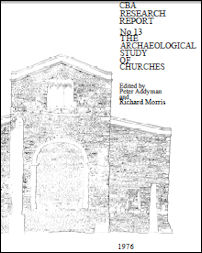CBA Research Reports
Council for British Archaeology, 2000. (updated 2020) https://doi.org/10.5284/1000332. How to cite using this DOI
Data copyright © Council for British Archaeology unless otherwise stated
This work is licensed under the ADS Terms of Use and Access.
Primary contact
Council for British Archaeology
92 Micklegate
York
YO1 6JX
UK
Tel: 01904 671417
Resource identifiers
- ADS Collection: 281
- DOI:https://doi.org/10.5284/1000332
- How to cite using this DOI
The archaeological study of churches
Peter Addyman & Richard Morris (editors)
CBA Research Report No 13 (1976)
ISBN 0 900312 35 1
Abstract

'It becomes increasingly evident that churches more than any other structure are likely to advance the understanding of settlement histories . . . (this) volume presents a number of specific studies to illustrate the variety of techniques and approaches now to be found in British church archaeology'. H M Taylor (3-9) examines the logical foundations for constructing the architectural history of any period, explaining the particular problems of Anglo-Saxon churches. A section on organization of church archaeology (10-17) contains the editors' description of the network of Diocesan Archaeological Consultants formed to improve communication between church authorities and archaeologists; and short contributions on Danish, German and Dutch organization come respectively from O Olsen, G Fehring and H Halbertsma. Part 3 (18-27) treats the documentary background, with L A S Butler and D Owen explaining the types of evidence available and their use by the archaeologist. Part 4 (28-64) is on approach and techniques, with papers on individual churches by R Cramp (Jarrow), J G Hurst (Wharram Percy) and S Knight (Upleatham), while P A Rahtz considers the wealth of information found in churchyards, and the dangers to which it is subject. K A and W Rodwell discuss the problems of investigating churches in current use, from local politics and sensitivities through practical problems like the display of research results. A D Phillips describes the recording of the York Minster rescue excavations, advocating the use of 9cm x 12 film with monorail camera and the indirect application of a Cartesian coordinate system. P A Rahtz's second contribution is on the 'total archaeology' being applied to Deerhurst church and village. Martin Biddle (65-71) on the widening horizons discusses continuity of site and settlement, the origins of churchyard burial, and structural problems. The Reverend Henry Stapleton offers a postscript.
Contents
- Title pages
- List of contributors (p vi)
- Preface by The Most Revered the Archbishop of York (p vii)
- Foreword by P V Addyman (p 1)
- Part 1 : The foundations of architectural history by H M Taylor (p 3)
- Part 2 : Organization
- Diocesan Archaeological Consultants: steps towards a plan for church archaeology in England by P Wade-Martins and R K Morris (p 10)
- Church archaeology in Europe today:
- The legal situation in Denmark by O Olsen (p 14)
- The legal situation in Germany by G P Fehring (p 15)
- Archaeology in historic churches in the Netherlands by H Halbertsma (p 15)
- References - Part 2 (p 17)
- Part 3: The documentary background
- Documentary evidence and the church fabric by L A S Butler (p 18)
- Documentary sources for the building history of churches in the middle ages by Dorothy Owen (p 21)
- References - Part 3 (p 26)
- Part 4: Approach and techniques
- St Paul's Church, Jarrow by Rosemary Cramp (p 28)
- Wharram Percy: St Martin's Church by J G Hurst (p 36)
- St Andrew's Old Church, Upleatham by Shirley Knight (p 40)
- The archaeology of the churchyard by P A Rahtz (p 41)
- The investigation of churches in use: a problem in rescue archaeology by K A Rodwell and W J Rodwell (p 45)
- Excavation techniques in church archaeology by A D Phillips (p 54)
- Research directions at Deerhurst by P A Rahtz (p 60)
- References - Part 4 (p 64)
- Part 5: The archaeology of the church: a widening horizon by Martin Biddle (p 65)
- Postscript by Rev Henry Stapleton (p 72)
- Index (p 75)
- Plates I to XIII (following page 79)
Download report
| The archaeological study of churches (CBA Research Report 13) | 3 Mb |







